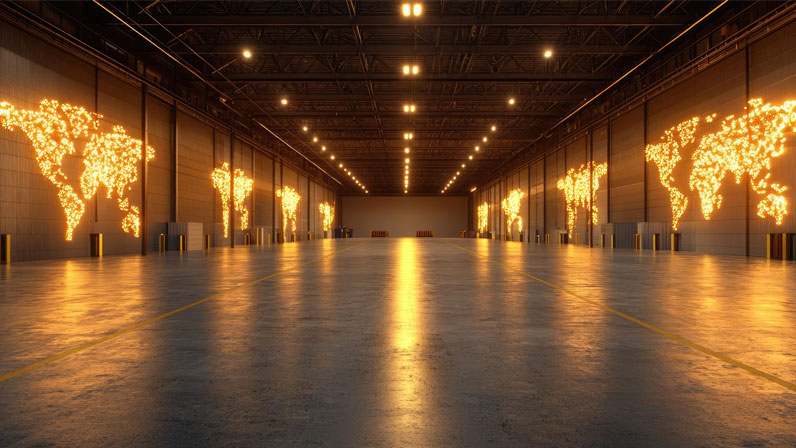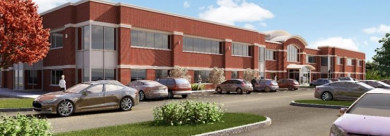In today’s fast-paced market, businesses face growing pressure to deliver products quickly, cost-effectively, and with exceptional accuracy. Traditional single-warehouse fulfillment can no longer keep pace with customer expectations or operational complexity. That’s where a multi-node distribution strategy—leveraging multiple regional warehouses—becomes a game changer. By decentralizing inventory and strategically placing warehouses closer to key markets, brands can improve delivery speed, reduce costs, and gain greater control over their supply chains. This blog explores why regional warehouse and logistics models are critical for B2B and e-commerce companies looking to scale successfully.
By decentralizing inventory and strategically placing warehouses closer to key markets, brands can improve delivery speed, reduce costs, and gain greater control over their supply chains. This blog explores why regional warehouse and logistics models are critical for B2B and e-commerce companies looking to scale successfully.
Highlights:
- What a multi-node distribution strategy means and why it matters
- How regional warehouses improve delivery speed, cost control, and inventory management
- The role of warehousing and distribution centers in enhancing omni-channel fulfillment
- Environmental benefits of distributed fulfillment models
- When to know it’s time to expand beyond a single warehouse
Today’s customers don’t just want fast delivery—they expect it. Whether you’re shipping products to e-commerce shoppers or replenishing inventory for retail stores and wholesale partners, speed, accuracy, and cost-efficiency are now table stakes. That’s why more and more businesses are moving away from the traditional single-warehouse model and adopting a multi-node distribution strategy supported by strategically located regional warehouse and logistics hubs.
This shift isn’t just a trend—it’s a smart, scalable solution to the growing challenges of modern warehousing and distribution. From rising shipping costs to fluctuating demand and complex returns, a regional approach offers more control, flexibility, and efficiency across your entire supply chain.
In this post, we’ll break down how multi-node distribution works, the key benefits it brings to B2B distribution, e-commerce fulfillment, and wholesale and distribution operations, and how Jillamy’s nationwide network of distribution centers and tailored 3PL services can help you stay competitive and grow confidently.
What Is a Multi-Node Distribution Strategy?
At its core, a multi-node distribution strategy means using multiple warehouses—or nodes—across different geographic regions to store and ship inventory. These nodes act as regional warehouses, each responsible for fulfilling orders within its surrounding area.
Rather than relying on one massive fulfillment center to serve customers nationwide, a multi-node model decentralizes your inventory. When a customer places an order, it’s routed to the closest warehouse that has the item in stock, allowing for quicker shipping, lower costs, and a better customer experience.
It’s like upgrading from one-size-fits-all to tailor-made fulfillment.

Why Regional Warehousing Matters More Than Ever
Let’s be honest: expectations around shipping and fulfillment have skyrocketed. Free 2-day shipping is no longer a novelty—it’s the norm. And whether you’re serving individual consumers or retail buyers, speed and accuracy can make or break your reputation.
At the same time, transportation costs continue to rise. Fuel surcharges, labor shortages, and increased demand all contribute to higher rates for parcel, LTL, and full truckload shipping. For companies relying on long-haul distribution from a single site, these costs can quickly eat into profit margins.
A regional warehouse and logistics model helps solve these problems. By placing inventory closer to end customers, you reduce transit times and lower shipping costs. Plus, you gain the flexibility to respond quickly to demand spikes, regional trends, and supply chain disruptions.
Key Benefits of a Multi-Node Distribution Strategy
Let’s dive deeper into the biggest advantages of this approach and why companies across industries—especially e-commerce, B2B, wholesale, and retail distribution—are making the shift.
1. Faster Delivery Times
When your inventory is physically closer to your customers, deliveries happen faster. It’s that simple.
With multiple distribution centers across the U.S., you can reach more ZIP codes in 1–2 days using standard ground shipping. That’s a huge perk for e-commerce brands trying to meet customer expectations without blowing their shipping budget.
In B2B distribution, faster delivery helps maintain tighter replenishment schedules and reduces lead times for retail partners—giving your business a stronger competitive edge.
2. Lower Shipping Costs
Shipping costs are directly tied to distance and delivery zones. The farther a package travels, the more it costs. By distributing your inventory across regional warehouses, you reduce average shipping distances and cut down on expensive zone 6, 7, and 8 deliveries.
This helps reduce reliance on premium shipping options and enables more cost-effective order fulfillment strategies. Whether you're using parcel, LTL, or full truckload shipping, routing orders from the nearest warehouse keeps costs manageable and predictable.
3. Smarter Inventory Management
You might think having multiple warehouses makes inventory more complicated—but with the right technology, it actually improves control.
Modern inventory management solutions track stock levels across every location, in real-time. This means:
- Improved inventory accuracy
- Reduced stockouts and overstocks
- Easier seasonal and promotional planning
- Better demand forecasting and regional rebalancing
You can allocate products based on regional sales trends, manage safety stock by location, and respond quickly to changes in demand. And if one location runs low, you can easily reroute shipments or replenish from another node.
Jillamy’s integrated warehouse systems provide full visibility into your product flow—across all nodes—so you’re always in the loop.
4. Increased Flexibility and Resilience
In a world of constant disruption—whether it’s severe weather, labor shortages, port congestion, or transportation delays—flexibility is essential.
When you rely on a single distribution center, a localized issue can paralyze your entire operation. But with a multi-node strategy, you can shift order fulfillment to other locations when needed, keeping your business moving even when things go sideways.
This redundancy improves business continuity and reduces risk. It also allows you to adapt faster to regional shifts, such as new retail partnerships, emerging customer bases, or local events.
5. More Efficient Returns Handling
Returns are a growing part of both e-commerce and wholesale and distribution operations. And they’re not just a customer service issue—they impact your bottom line.
With regional warehouse and logistics hubs, returns can be processed locally rather than shipped back to a central location. This speeds up the reverse logistics process and reduces associated transportation and labor costs.
Plus, returned products can be inspected and restocked more quickly, helping preserve resale value and improve inventory turnover.

Who Benefits from a Multi-Node Strategy?
You don’t have to be a Fortune 500 company to benefit from distributed fulfillment. In fact, multi-node distribution is especially helpful for:
- E-commerce brands expanding to new markets
- B2B suppliers with national retail accounts
- Wholesale distributors with multiple sales territories
- Subscription services looking to speed up delivery and control costs
If your current setup is struggling to keep pace with demand, rising costs, or customer expectations, regional warehousing might be the solution you've been looking for.
How Regional Warehousing Supports Omni-Channel Success
For brands that operate both online and in brick-and-mortar environments, flexibility across channels is essential. A multi-node distribution strategy is a foundational element of successful omni-channel fulfillment. When you can pull inventory from the nearest distribution center—whether for a DTC order, a retail store restock, or a wholesale client—you gain the agility to serve every channel with speed and precision.
Let’s say a flash sale on your website spikes demand in a specific region. A traditional warehouse model might struggle to keep up with delayed deliveries or out-of-stock notifications. But with inventory split across regional locations, your operation can meet that demand head-on—without disrupting other channels or overextending your fulfillment team.
This is where inventory control becomes a true competitive advantage. You’re no longer reacting to issues—you’re anticipating and solving them before they impact customer satisfaction.
The Environmental Benefits of Distributed Fulfillment
Today’s consumers and B2B buyers care about sustainability. They want products delivered quickly—but they also want companies to reduce their carbon footprints. With a multi-node model, you can align your fulfillment strategy with your environmental goals.
Fulfilling orders from a nearby regional warehouse reduces the miles traveled per shipment, which cuts emissions and fuel consumption. Over time, these small changes add up to significant environmental impact—and they can also improve brand perception.
Partnering with a third-party logistics warehouse like Jillamy means your business benefits from shared infrastructure that is optimized for sustainability, including efficient packaging practices, consolidated shipments, and optimized delivery routes.
Overcoming Common Challenges of a Multi-Node Strategy
It’s important to acknowledge that while a multi-node distribution approach comes with major advantages, it does require thoughtful planning and execution. Some challenges include:
- Increased complexity in inventory management
- Initial setup costs for additional warehouses
- Need for real-time communication and system integration
However, these challenges are easily managed when you work with an experienced 3PL partner. Jillamy’s inventory management solutions provide centralized visibility across all nodes, allowing you to monitor stock, coordinate replenishments, and automate order routing. Our integrated systems sync seamlessly with e-commerce platforms, ERP systems, and retail portals to streamline fulfillment, even at scale.
You don’t need to figure it all out alone—we’re here to guide the process and set your business up for long-term success.
When is the Right Time to Scale to a Multi-Node Network?
Not every business starts out with multiple warehouses. But as your customer base grows and your product line expands, it’s important to recognize when your current model may be limiting your growth.
Here are a few indicators that it might be time to scale up your distribution warehousing network:
- You’re shipping from one warehouse to customers nationwide
- You’re spending more on shipping than you did 12 months ago
- Your transit times are creeping past the 2-day mark
- You’re entering new geographic markets
- Your returns process is slow or expensive
- You’re storing overflow inventory off-site
If you’ve checked even one of those boxes, it’s worth exploring what a regional warehouse and logistics strategy could do for your bottom line and your customer experience.

How Jillamy Supports You Beyond Warehousing
While warehousing and distribution are a core part of our business, Jillamy offers a full suite of 3PL services to help you optimize your entire operation. We’re more than just a warehouse—we’re an extension of your team.
Here’s how we support our clients across the supply chain:
- Customized fulfillment plans based on order volume, product type, and growth trajectory
- Value-added services like kitting, promotional inserts, custom packaging, and labeling
- Wholesale distribution support for brands that serve both retailers and individual consumers
- Storage solutions tailored to your product mix, including temperature-controlled and high-security areas
- Returns management that reduces friction and accelerates restock times
- E-commerce integrations with major platforms like Shopify, WooCommerce, and BigCommerce
Whether you need a 3rd party logistics warehouse to offload a specific region or a full-scale fulfillment partner to run your national distribution strategy, Jillamy has the infrastructure, experience, and flexibility to meet your needs.
Final Word: One Size Doesn’t Fit All—And That’s the Point
Gone are the days when one massive warehouse could handle it all. Today, flexibility, speed, and cost-efficiency are critical. A multi-node distribution strategy gives your business the ability to scale strategically, serve customers better, and respond to market shifts with confidence.
By placing inventory closer to your customers with regional warehouse and logistics hubs, you not only reduce costs and improve delivery times—you build a more resilient and future-proof operation. Whether you're focused on B2B distribution, wholesale and distribution, or direct-to-consumer sales, decentralizing your fulfillment network puts you in control.

Let’s Talk About Your Distribution Goals
If you're ready to rethink your warehousing and distribution approach, Jillamy is ready to help. We’ll work with you to develop a customized multi-node distribution strategy that fits your business now and grows with you into the future.
Get in touch with Jillamy today to explore our regional warehouse locations, learn more about our inventory control tools, and discover how we make fulfillment smarter, faster, and easier.


